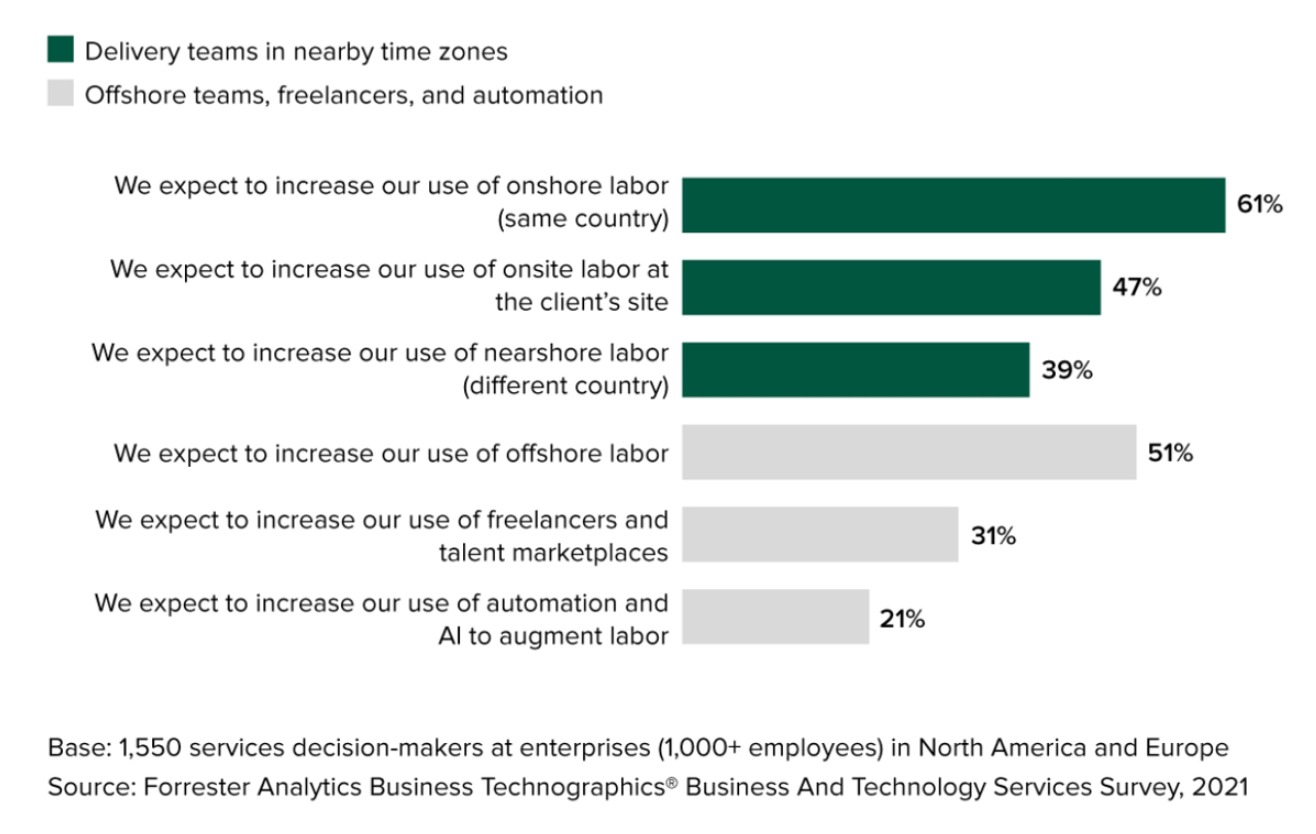 News
News
Nearshore staffing has completely revolutionized the outsourcing industry in recent years, with more and more North American organizations opting for this hiring strategy to minimize costs while maintaining maximum efficiency. Traditionally, nearshoring was understood purely in geographical terms. Businesses would outsource processes to neighboring countries, often to take advantage of lower labor costs or more favorable regulatory environments. For example, U.S. companies would often nearshore their production, operations, or services to Mexico or other LATAM countries, while European businesses would look to Eastern Europe. Now, nearshore outsourcing is becoming increasingly relevant, with 39% of decision-makers from US and EU companies choosing to work with professionals from neighboring countries in the future. In this article, we’ll explore the evolution of the so-called nearshore meaning and the reasons behind this model being one of the most popular hiring strategies of recent years.
The Traditional Nearshore Meaning
The typical meaning of nearshoring revolves around the concept of relocating business processes or services to neighboring or nearby countries, rather than to distant locations. This practice is a subset of outsourcing and contrasts with offshoring, which involves moving operations to a distant country, often on the other side of the world. For instance, a US company outsourcing work to India or Pakistan.
The fundamental differential of nearshoring is its emphasis on proximity. Companies opt to outsource their business processes to countries that are geographically closer to their home base. This proximity can offer several logistical advantages, including similar time zones, which facilitate real-time collaboration and communication. Because of this proximity, nearshoring often involves partnering with countries that share cultural and linguistic ties with the company's home country as well. These similarities can lead to better collaboration and understanding, reducing the chances of any misunderstandings or cultural miscommunications happening.
Evolution of Nearshoring: Beyond Convenient Locations

Over time, the concept of nearshoring has evolved significantly. It's no longer simply about geography and reducing costs to the minimum. It has become a strategic decision based on a combination of factors including:
Technological advancements: The proliferation of digital tools and platforms has made it easier for businesses to collaborate with teams located in different parts of the world.
Globalization: As businesses expand globally, they need partners who understand local markets and can help them navigate cultural and regulatory nuances.
Changes in international trade policies: Shifts in trade agreements and policies can make nearshoring more attractive as businesses try to manage risks associated with their supply chains.
Nearshore Meaning Today: A Multi-Faceted Concept
Today, nearshoring goes beyond convenient cost savings. It's about finding the right balance between cost, quality, and efficiency. It's about working with partners who can bring value-added services, from process optimization to innovation. Companies from all niches are leveraging nearshoring not just to cut costs but also to gain access to new markets with larger talent pools, new skills, similar work schedules, and lower prices. Nearshoring has evolved into a multi-faceted concept today, reflecting the diverse needs and strategies of businesses in a world that only continues to become more interconnected across nations. Here are some of the key aspects of nearshoring:
Cultural and Time Zone Alignment:
Nearshoring offers a closer cultural fit and similar time zones, which facilitates communication and collaboration. This is crucial in software development where agile methodologies and real-time collaboration are key. LATAM time zones are extremely convenient for North American companies, offering major overlaps during working hours.
Easier Talent Access:
It's not just about cost savings anymore. Companies look to nearshore locations for access to specialized talent pools. Latin America has become a hub for tech talent, making it an attractive nearshoring destination for North American companies amidst the tech talent gap happening in the US.
Flexibility and Scalability:
In a fast-paced economy where stability is a luxury, the ability to scale up or down quickly is vital. Nearshoring provides this flexibility, allowing companies to respond to market changes or project needs more effectively by downsizing or growing their teams as needed.
Corporate Diversity:
There's a growing emphasis on promoting a diverse workforce. With nearshore meaning international teams being easier to assemble, this hiring practice can bring tremendous growth and cultural richness to your company.
Tech Advancements and Infrastructure:
Improved technology infrastructure in many nearshore countries has made collaboration easier and more efficient, further boosting the appeal of nearshoring.
Uplifting the Global Economy:
Nearshoring can boost the global economy by creating jobs in nearshore countries and allowing businesses to operate more efficiently. However, it's not without its challenges. There can be issues around quality control, intellectual property protection, and managing a dispersed workforce. Nonetheless, the overall impact of nearshoring on the global economy is positive, contributing to growth and development in many regions.
Future Trends in Nearshoring
Nearshore software development stands at the forefront of modern hiring strategies, perfectly blending cost savings with quality assurance. It offers a pragmatic solution for businesses looking to stay competitive in the fast-paced tech world while keeping a tight grip on their budget. As companies continue to navigate the complexities of software development and IT staffing, nearshoring emerges as a balanced, cost-effective, and high-quality approach, aligning perfectly with the contemporary needs of each industry.
Increased Focus on Quality Over Cost:
While cost-efficiency will remain important, the emphasis will shift towards the quality of output and the value added by nearshore teams. Businesses will prioritize skilled talent and innovative solutions that nearshore partners can provide, rather than just lower costs.
Greater Integration of AI and Automation:
Nearshoring will increasingly involve AI and automation technologies. This will streamline processes, reduce manual effort, and enhance efficiency. Nearshore partners might be engaged not just for software development but also for integrating AI into various business processes.
Expansion into New Geographic Regions:
Currently, nearshoring is often region-specific (like U.S. companies partnering with Latin American firms). In the future, we might see this expand into new, untapped markets, offering a wider range of options for businesses seeking specific expertise or cultural alignment.
Sustainability and Ethical Practices:
There will be a growing emphasis on environmental sustainability and ethical practices in nearshoring arrangements. Companies will seek nearshore partners who adhere to green policies and demonstrate social responsibility, reflecting their own corporate values.
Enhanced Cultural and Business Alignment:
Future nearshoring will likely emphasize deeper cultural and business alignment. This means partners will not only share similar time zones and languages but also have a strong understanding of each other's business environments, regulatory frameworks, and market dynamics.
Nearshore Software Development: The New IT Hiring Strategy for Maximum Cost Savings
A major industry where businesses are perpetually seeking strategies that balance cost efficiency with high-quality output is software development. IT solutions continue to rise in cost and complexity and skilled professionals in this area are lacking. Enter nearshore software development - an approach that is rapidly gaining traction as the go-to IT hiring strategy for companies aiming to maximize cost savings without compromising on quality.
At its core, nearshore software development involves partnering with software development teams located in nearby countries, rather than distant offshore locations. This model offers a sweet spot between the traditional offshore outsourcing model and the costlier onshore alternatives. Here’s why hiring nearshore - meaning developers in nearby countries - can help your business!
Reduced Operational Costs:
Unlike offshore outsourcing, nearshoring significantly cuts down on the hidden costs associated with large time zone differences and cultural gaps. The closer proximity means less travel expense and more manageable working hours, leading to cost-effective coordination and project management.
Optimized Communication and Collaboration:
The nearshore model thrives on cultural similarities and closer time zones, fostering smoother communication. This alignment not only speeds up project timelines but also reduces the likelihood of costly misunderstandings or delays, thus optimizing the software development process.
Access to Specialized Talent at Competitive Rates:
Nearshoring opens doors to a pool of specialized talent in neighboring countries, where the cost of living and salary expectations may be lower than in the home country. This means access to high-quality skills at more affordable rates, a key factor in driving cost efficiency.
Enhanced Scalability and Flexibility:
With nearshore development, companies can quickly scale their IT teams up or down based on project requirements. This flexibility avoids the long-term financial commitments of hiring full-time onshore staff, leading to significant cost savings.
Risk Mitigation and Stability:
Political and economic stability in nearshore countries can offer a more predictable business environment compared to offshore options. This stability mitigates risks associated with outsourcing, such as political upheaval or currency fluctuations, which can have unforeseen financial implications.
Try Nearshore Software Development With Blue Coding
As we mentioned, nearshore software development has gained significant traction in recent years. The benefits are clear, from cost-effectiveness and access to a large talent pool to time zone alignment that ensures seamless communication. With the evolution of IT staff augmentation, businesses can now hire nearshore developers for short-term projects or expand their teams rapidly without worrying about long-term commitments or overhead costs.
At Blue Coding, we understand the importance of maximizing efficiency at your company, which is why we offer customized nearshore staff augmentation services to help you hire LATAM developers for a fraction of the cost. We believe in having a people-first approach that allows our expert recruitment team to find the best fit for your organization. If this sounds like what you’re looking for, contact us today to schedule a free discovery call and learn more about nearshoring!



